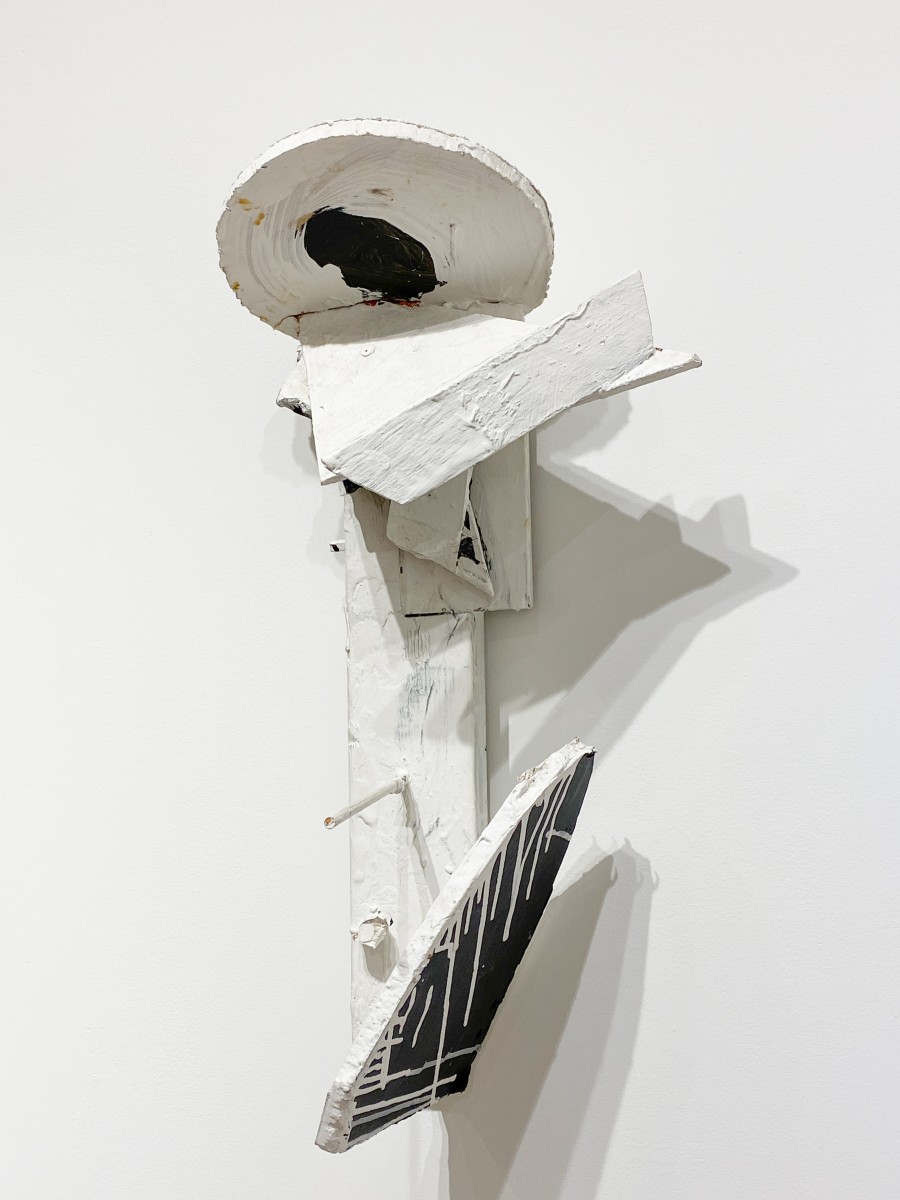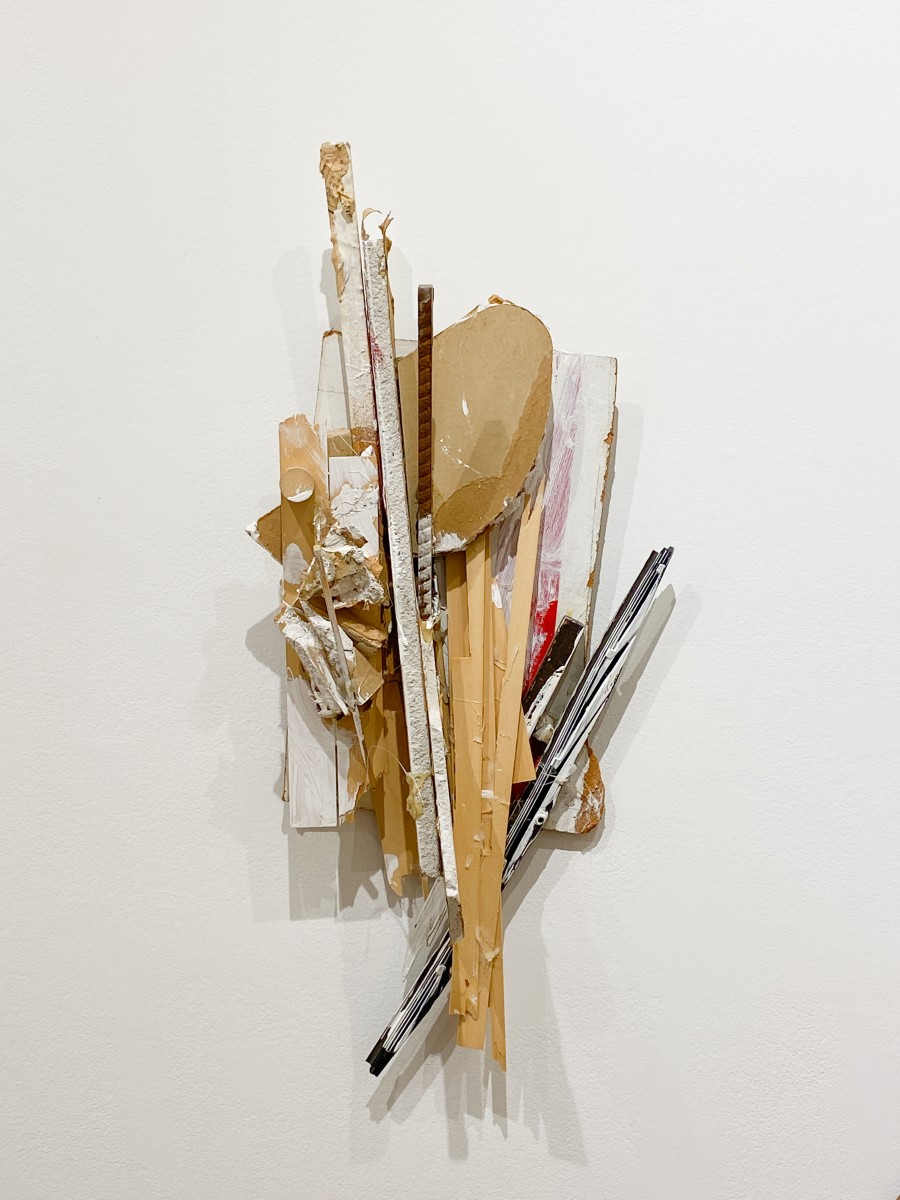Forging pathways
We spoke to Bryce Kanbara, Governor General’s Award-winning artist and curator, about his recent solo exhibition, Grace – on view at Centre[3] until August 20.

Bryce Kanbara, Angler (1987). Grace, installation view. Photo by Jeff Chow. Image courtesy of Centre
Among the many who have originated from and been involved with Hamilton’s arts community, Bryce Kanbara is perhaps one of the best known. Grace, an exhibition on view now at Centre[3] in Hamilton, recognizes Kanbara’s work not only as an artist, but as a resolute and active community builder.
Grace, curated by Centre[3]’s Artistic Director Lesley Loksi Chan, features a selection of Kanbara’s three-dimensional, wall relief sculptures; drawn from the ongoing series the Japanese-Canadian artist began in the 1980s. These assemblages – fastened to the wall, made of all manner of found objects cobbled together with screws, nails and more – speak to “how daily life entwines with intergenerational knowledge and cultural histories”. Inhabiting somewhere in between specificity and ambiguity, they subtly allude to the personal and collective everyday experiences of nikkei (immigrants and descendants of Japan), generations past and present. “Amongst the rawness of these structures, Kanbara occasionally nestles various mementos including a googly-eyed seashell handicraft won at a Lithuanian church dinner raffle, a faintly pencilled stanza of a Christopher Smart poem, stray wooden lids of daikon-pickling pails handmade by his father, or a small painting of an archival photograph depicting POWs at the burial of Mr. Masanoa Shirokowa, a 46-year old issei, in Angler, Ontario, where his father was interned along with other Japanese-Canadian dissidents in the 1940s.”
Kanbara has been working for nearly five decades: across media in painting, printmaking and sculpture, and as a curator and arts administrator. He was a founding member and the first administrator of Hamilton Artists Inc. (known then as Hamilton Artists’ Co-op) in the late 1970s and early ‘80s, going on to hold curatorial positions at Burlington Art Centre; Art Gallery of Hamilton; Glenhyrst Art Gallery of Brant; JC Gallery at the Japanese Canadian Cultural Centre (Toronto). He was also Executive Director of the Toronto Chapter, National Association of Japanese Canadians, Chair of the NAJC Endowment Fund and National Executive member. As one of the first to open a gallery space along Hamilton’s James Street North in the early aughts, Kanbara has been the proprietor of you me gallery since 2003. In 2021, he won a Governor General’s Award in Visual and Media Arts for his countless contributions.
Before the exhibition closes on August 20, Kanbara answered a few of our questions about his work.
AGOinsider: What does “grace” mean to you? Do you feel that your definition applies to your work and practice?
Kanbara: “Grace” may not seem to fit these inelegant-looking objects, but I’m often drawn to irony. The word “grace” was included in a stanza of an 18 Century poem by Christopher Smart which I pencilled on the very first drywall relief I made in the 1990s. I like the Christian connotation of being redeemed or made worthy regardless of one’s shortcomings.
AGOinsider: What was it about your first wall relief sculpture that prompted you to create a series of them over the years?
Kanbara: It was the feeling of exhilaration that accompanies creative discovery – in this case, of moving from 2-D to 3-D. That may sound simplistic and archaic, but if it weren’t for the sheer pleasure I derive from the kind of intuitive artmaking I do, I would be doing something else. In the late 1980s, I had begun a period of steady curatorial work which consumed most of my time. Using discarded drywall was an ideal way to continue making things because it’s so easily found, easy to break and cut, and glue and screw together.
AGOinsider: For the wall relief sculptures that are on view, what was your selection process like working with Lesley Loksi Chan, the exhibition’s curator? What considerations, aesthetically or otherwise, had to be made?
Kanbara: At first it seemed unfathomable to me that Lesley Chan, who is an esteemed experimental filmmaker and whose art practice is precise in thought and execution would notice, let alone appreciate, these pieces which appear to be in total contradiction to her own artistic sensibility. I quickly realized how fortunate I was to be entrusting the presentation of my work to a talented curator whose perceptions are wide and deep. As a curator myself, I’m intrigued by how other curators curate and left all the decisions regarding the selection and installation of works to her.
AGOinsider: You’ve said that community is integral to everything you do, a sentiment you expressed when you received a Governor General's Award in Visual and Media Arts in 2021. What has been the most meaningful lesson that your work as community builder has taught you?
Kanbara: In spite of our best intentions individually and collectively to reach out, understand and support one another, we tend to live in insular worlds. I believe in the importance of going out of our way to make personal contact with people whose experiences are different from ours, getting to know them a little, visiting their community spaces, and attending their public events. We don’t do that much.
AGOinsider: Much has been said about how Hamilton, Ontario’s James Street North and the city’s arts scene overall have evolved, especially since the early to mid-2000s. What would you say has endured about the art and artists from Hamilton since that time and even before it? Is there something distinct about art and artists from Hamilton?
Kanbara: There’s going to be a massive, salon-style exhibition [titled] Art in Hamilton (1950-2000) at the Art Gallery of Hamilton this fall [opening September 8]. It’s meant to be an inclusive celebration of the artists who were around in those years when the new AGH was built downtown and many art organizations were established such as Hamilton Artists Inc., Dundas Valley School of Art, Carnegie Gallery and Hamilton Arts Council. Most Hamilton artists were involved in those organizations at one time or another and a strong, regional sense of community was built. Hamilton’s art scene has experienced a dramatic change since 2000, with the rise and decline of James North as an arts district, and the influx of artists from Toronto. The AGH exhibition will be a timely reminder of Hamilton artists and their contributions, and how effort and goodwill are needed to make things work – and worthwhile.
Bryce Kanbara: Grace is on view at Centre3 in Hamilton until this Friday, August 20, 2022.



